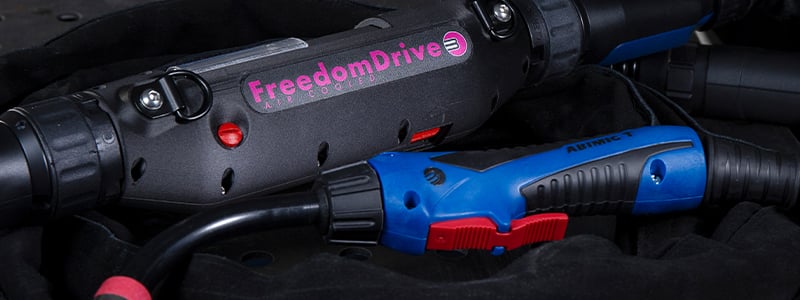There is no question that aluminum has special characteristics that require it be welded different than other metals. Aluminum is a very soft metal, with a high melting point that requires high voltages. Distorting aluminum is easy and can happen pretty quickly, as the wire will start oxidizing almost immediately, leading to a host of issues. Spool guns were designed to help feed difficult wire in an effort to avoid messy welding by placing the feeder right on the gun. Reliable wire feeding is among the most important parts of welding.
Now the question is, do you need a spool gun to weld aluminum or is there an alternative?
The answer is yes and no, depending on the user’s preference, you do not necessarily need a spool gun to weld aluminum. Depending on the application, some have found success in taking a ten- or twelve-foot MIG gun and running a Teflon liner through it, then calling it a day. This may work especially well if you are welding heavy, thick material above about a half inch or more. Generally, people will run this off of a fifteen-pound spool.
You can go that route, but in some cases, you’ll see a lot of travel trailer or boat manufacturers who use spool guns because they are running 25-feet or longer. The spool sits right on top of the gun, which leads to less friction happening and less feed ability issues.
A spool gun is really great for somebody who is doing a lot of longs runs and needs something portable. You are less likely to have a burn back issue with the spool gun than you are with a regular MIG gun because it has to feed “x” amount of feet and everything is driven by the welder itself. Plus, you have a motor right on the spool gun, with some drive rolls there as well, which helps to push it.
The problem with spools guns is that they are big, bulky, heavy and relatively expensive. In addition to that, they have poor accessibility due to their size. If you are a shop manager who looks at efficiency, you’ll want to consider the setbacks. Do you know how many times you have to change out a one-pound spool gun? Sometimes, you have to do them multiple times throughout the day. When looking at the time and labor, this can be extremely inefficient. Especially if you are running around trying to find replacements for the spool. It does depend on what application it is, but if you are welding a lot, spools can go quick. Meaning the cost per spool will just continue to grow over time.
Everything comes down to the needs of your application. The last thing I would want to do is tell someone, “no, you can’t use a spool gun.” Spool guns can be tricky because you have to make sure you have the right welder that can support the gun. If they can’t, that’s when you will want to consider the 10- or 12-foot standard MIG gun, while keeping in mind that the gun needs to be as straight as possible to keep the soft wire from kinking and causing any setbacks in feeding.
In addition to inefficiency, there is a lot of maintenance when it comes to a spool gun. There are many little pieces involved, which makes the overall process a little more tedious. Once you get it working, you will have successful runs.
Spool guns have a place, but you do need to consider the duty cycle of a spool gun. The majority of machines that you see out there are running around 60% to 100% duty cycles. This is something you will want to keep in mind.
You should question – What are you welding? Are you doing this in your garage or for a production run?
That’s how you determine whether or not you will need a spool gun. Some first-time users, those just learning about the welding process, may benefit from a spool gun. They’re easy to use and just require some fine tuning, leading you to less feeding issue up front and burn back issues can be reduced. A lot of the big productions are laying down a few hundred feet a day, meaning they will need to change out that one pound spool many times.
Looking for a new alternative to push-pull welding applications? Meet our new product, FreedomDrive™. Interested in learning more? Click the link below.



